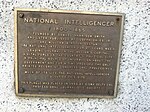Baltimore and Potomac Railroad Station
Assassination of James A. GarfieldAssassination sitesBuildings and structures demolished in 1908Demolished buildings and structures in Washington, D.C.Demolished railway stations in the United States ... and 9 more
Former Pennsylvania Railroad stationsHistory of Washington, D.C.National MallRailway stations closed in 1907Railway stations in Washington, D.C.Railway stations in the United States closed in the 1900sRailway stations in the United States opened in 1873Use American English from July 2022Use mdy dates from July 2022

The Baltimore and Potomac Railroad Station, also known as Pennsylvania Railroad Station, was a railroad station that was owned by the Pennsylvania Railroad and operated by the Baltimore and Potomac Railroad in Washington, D.C., from July 2, 1872 until its closure in 1907. It was located at the southern corner of 6th street NW and B Street NW (now Constitution Avenue), now the site of the West Building of the National Gallery of Art. It was in this train station that United States President James A. Garfield was assassinated by Charles Guiteau.
Excerpt from the Wikipedia article Baltimore and Potomac Railroad Station (License: CC BY-SA 3.0, Authors, Images).Baltimore and Potomac Railroad Station
Constitution Avenue Northwest, Washington
Geographical coordinates (GPS) Address Nearby Places Show on map
Geographical coordinates (GPS)
| Latitude | Longitude |
|---|---|
| N 38.891666666667 ° | E -77.020277777778 ° |
Address
Constitution Avenue Northwest
20554 Washington
District of Columbia, United States
Open on Google Maps









